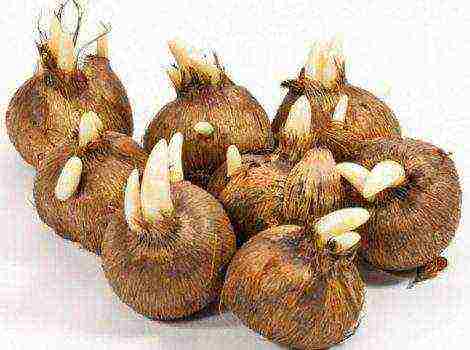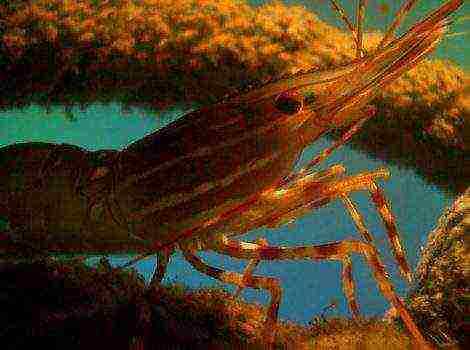Content
- 1 How to grow hyacinths outdoors
- 2 Pick-up location
- 3 Outdoor cultivation
- 4 Landing rules
- 5 Spring care
- 6 Preparing for the new season
- 7 Why hyacinths are grown in pots
- 8 Correct distillation of flowers
- 9 How to choose a good, healthy plant in the store
- 10 The purchased flower was brought home, how should you care for it?
- 11 What care to provide hyacinth after flowering
- 12 Diseases and pests
- 13 Reproduction of hyacinths at home
Many summer residents strive to grow hyacinths on their site, planting and caring for which in the open field require a certain amount of time. In this article, we will look at how to grow these beautiful flowers (even in those regions where the ground freezes in winter), when to dig up hyacinths, how to store bulbs, how to propagate your favorite variety.
Hyacinths in a flowerbed (photo by Nadezhda Abramovich, Krasnodar)
In early spring, as soon as the snow melts, green arrows of hyacinths sprout from the ground. This flower with a charming and pronounced aroma differs in all shades of the rainbow. Inflorescences in the form of tassels can be either regular or terry in structure; there are usually 20-30 buds on the peduncle.
↑ to the content ↑ Planting hyacinths in the ground - the choice of bulbs and places for planting them
Perennial hyacinth is a bulbous crop, the size of the bulb may vary depending on the type of flower. The planting material is considered an adult by the age of 5-6, when it is fully formed. The tuber is a scaly sphere with a bud of renewal - it is this that affects its growth. By the 5th year, adult bulbs usually acquire babies, which are formed near the bottom and are hidden under the scales.
Hyacinth, photo of flowers:
When choosing tubers, you should pay attention to the following nuances:
- Terry bulbs are often smaller than their regular bulbs.
- To grow flowers outdoors, the tuber must have at least 4 cm in diameter, a full-fledged active bud and multiple scales. Elasticity and heaviness are indicators of the healthy state of the bulb.
- The appearance of the bulb should be perfect - no damage, loose sides, mold.
- On the lower part of the tuber (near the bottom), root primordia should be present.
- The bottom of a suitable bulb for planting should be about one and a half to two times smaller than the bulb itself (we are talking about volume).
The key to a long and lush flowering is not only high-quality planting material, but also the planting site itself. You can set up a flower garden near trees or bushes, but not very close to them. The place for plants should be calm, well lit by the sun's rays. The soil is needed loose, if your site is dominated by black soil or loam, then it is advisable to add peat to it in advance (sand is also possible). Sod land or deciduous humus are excellent conditions for the development, growth and flowering of hyacinths.
As a fertilizer, organic matter gives good results, but you should not use manure.If the soil is acidic (pH above 6.5), then it should be diluted with dolomite (limestone) flour. Hyacinth tubers do not like excessive moisture very much. If on your site groundwater runs close to the surface (closer than 0.5 m), you cannot do without arranging high beds. In addition, the plants will have to provide a high-quality drainage substrate, as well as make a slight slope of the ridge - for better outflow of water during rains, spring melting of snow. With the arrival of spring, high beds are warmed up faster by the sun's rays, hyacinths bloom much earlier.
↑ to the content ↑ Growing hyacinths in the open field
It is highly desirable to prepare the soil in advance - to dig it to a depth of about 40-45 cm and add the required additives (depending on the composition and condition of the soil). Limestone (200 g), wood ash (150 g), superphosphate (50-70 g), magnesium sulfate (10 g) or potassium (20 g) are added at an approximate rate of 1 m² of land. So that the fragile young roots are not damaged during planting, digging up the soil in the place of the future flower garden is also important. During the deepening of the bulbs, the soil temperature should be approximately 8-11 degrees, the distance between the tubers should be no more than 10-15 cm. If the flowers are planted in the beds, then the row spacing should be approximately 18-22 cm. If you want different varieties of hyacinths bloomed at the same time, make sure that all tubers are approximately the same in size.
Hyacinth, photo of bulbs:
A good time to plant bulbs is mid September / October. It should be borne in mind that if you plant a tuber too early, then it will begin to develop, but it will not survive the winter. If you plant hyacinths too late, then they will not have time to take root and get used to the place - accordingly, they will also die. If you are late with landing, then hurry up by the first week of November - this is the latest date. To do this, you will have to resort to additional measures.
The place for the future flower garden is mulched with leaves or some other suitable material, covered with plastic wrap to keep warm. After the tubers are buried, the site is sprinkled with sawdust or peat, and it can also be covered again with foliage or coniferous spruce branches. A special covering material is excellent for this purpose. With the arrival of the first days of spring, the protective cover can be removed to make way for the emerging hyacinth sprouts.
As mentioned above, the bulbs should be healthy, but if you are still afraid of fungal manifestations, you can first soak them in a fungicide solution. The width and depth of the hole for the tuber should be equal to two of its sizes - about 15-25 cm, you can pour a little sand on the bottom, and then bury the tuber with the bottom down (about 13-15 cm). Sprinkle the bulb with soil, which needs to be tamped lightly, then watered. The root system of the plant absorbs moisture and nutrients from the ground within a radius of about 20 cm from the tuber - this should be taken into account. Small onions should not be deeply buried; they should also be planted quite thickly.
↑ back to content ↑ How to care for hyacinth
After the protective cover is removed, caring for the plants will consist in weeding, regular watering, loosening the soil, and applying top dressing. It should be borne in mind that hyacinths are bad for the neighborhood of weeds. When buds begin to set and flowering time comes, fertilizing the soil becomes especially relevant. After sprouting, the flowers can be fed with saltpeter (25-30 g per 1 m²).
The second stage of fertilization follows during the period when the buds are gaining color. Now, in addition to ammonium nitrate, you can add potassium chloride (25 g) and a phosphorus additive (for example, superphosphate, 35 g). At the end of flowering, superphosphate and potassium chloride are applied to the site - 35 g of each product per 1 m² of the area.The aisles or spaces between flowers are treated with fertilizers; after top dressing, watering always follows.
Hyacinths - how to care after flowering? Unfortunately, this wonderful period is fleeting; after the flowers have dried, the roots should be saturated with moisture. For tubers to recover well after flowering, watering and fertilizing should be in the first place. If you live in a "cold" region, then you cannot leave hyacinths for the winter, they will have to be dug out - these are necessary measures for the further favorable formation of replacement buds.
If you live in the Kuban, in the Crimea, in the north of the Caucasus, then the annual digging of tubers can be avoided, but only under the condition of a very hot summer. It should be borne in mind that the bulbs left in the ground will give much fewer flowers next year.
From my experience, I can share this observation: I accidentally dug up several bulbs of hyacinths, forgetting that they grew in my place. I didn’t begin to dig in, as it was urgently necessary to plant a rose seedling. And I forgot about them, leaving them lying on the porch. Accidentally stumbled upon them only in the fall. Planted. And in the spring I was surprised by the large peduncles, abundantly dotted with flowers, which crawled out of the ground in this very place. Other hyacinths also bloomed, but their blooms were much more modest, something like the one in the photo below.
Hyacinths have not been transplanted for a long time (photo by Anna Nepetrovskaya, Novokubansk, Krasnodar Territory) ↑ back to content ↑ When to dig out hyacinths after flowering
The optimal period is the last weeks of June - the first half of July, when the leaves of the plant turn yellow and weak. The ground part of the flower is removed, the tubers are removed from the soil, washed with water and thoroughly dried. Then we carry out an audit - we throw away the damaged (or with obvious signs of illness) specimens. If there are undeveloped babies on the bulb, they are separated and set aside for growing. Before storage, all tubers are subject to treatment against diseases and pests.
Planting material, photo:
After all the manipulations, the bulbs should be aged for about 7-10 days in a well-ventilated place at an air temperature of +17 .. + 20 ° C. To do this, they need to be laid out on clean paper, and after the specified time has expired, they must be hidden in paper bags. It is the period after flowering, as well as the processing and storage time of tubers, that are most important for hyacinths. At this time, the planting material is acclimatized, the scales dry up, the tubers are prepared for the summer period.
At a sufficiently high summer temperature, air and moderate humidity should be provided to the bulbs (if the thermometer reaches + 30 ° C). About three weeks before planting, the temperature in the room with the bulbs should be lowered to + 16 ° C to help them adapt before planting.
↑ back to content ↑ How to propagate hyacinths at home
Separately, it is worth considering the methods of reproduction, since the tubers can give flowers for two or three years, but at the same time they will not form children. For this, the bulbs need stimulation, it is carried out in various ways.
↑ to the content ↑ Cutting the bottom of the hyacinth tuber
Even during planting, the place where the largest bulbs are planted is determined on the site. After the leaves of the plant turn yellow, the tuber is removed from the ground and immediately, without letting dry, arrange a "shower" under the strong pressure of water. During this process, old scales are removed along with the soil. Next, the bulbs are laid out in one layers in a ventilated box, taken out to a shaded place, dried for about 7-10 days. After this time, using a sharp knife, a wedge-shaped cut is made on the bottom, in which the kidney and the bottom itself are completely removed. The cut site must be treated with crushed activated carbon.
After this operation, the tubers are laid out in a container, the bottom of which is covered with a layer of perlite. The bulbs should be placed with the cut bottoms up.Next, the container is placed in a large plastic bag (you can use garbage bags) to create the required microclimate. At a temperature of + 30 ° C and high humidity, babies will appear at the cut site, and after 2-3 months they will reach about 1 cm, acquire root buds and sprout small processes. If the bottom was cut out in the first months of summer, then the tuber with children can be planted in the soil and covered with sawdust (or peat).
If time is missed, then the tubers are turned upside down, placed in a container with soil, placed in the cold (refrigerator, basement), and with the onset of spring they are planted on the site.
After the hyacinths have faded, what to do with them? With the onset of August, these tubers are dug up (by that time they are already covered with children), the children are separated. By early September, the young generation of hyacinths is buried in the soil, covered with a 10 cm layer of mulch (sawdust, spruce branches, foliage, peat). At the end of the first wintering, the mulching layer is removed, but left in place after the second winter. In the third year, these hyacinths give color and delight you with a wonderful aroma.
↑ to contents ↑ Reproduction by scales from bulbs
Large tubers (about 5-6 cm in diameter) are cut into 4 parts, after which some scales are separated from the bottom, the "wound" surface is treated with crushed activated carbon. Next, a container is taken, at the bottom of which perlite or clean sand is poured; you can also use crushed charcoal with ash. Broken flakes are placed in this container, then it is placed in a transparent plastic bag, tied securely and kept for 2 months in not too bright light.
At the same time, the air temperature should be approximately + 19..23 ° С, but at the second stage, which lasts a month and a half, the temperature should be reduced to + 16..19 ° С. During this period, several bulbs will be tied on the scales. Young stock storage is similar to the method described in the first method.
↑ to the content ↑ Propagation of hyacinths by cuttings of a leaf
To do this, you should wait for the period of the ovary of the peduncles and separate from the hyacinths by a couple of leaves, they must be cut as close to the base as possible. Then the leaves are treated in a solution that stimulates root formation (for example, "Heteroauxin") and buried 3-4 cm in a container with clean sand (or perlite). This container, again, is enclosed in a plastic bag, tied up and placed in a moderately lit place for a month and a half. The air temperature should vary within + 10..17 ° С, humidity - 80-90%. After the specified period, you can see bulbous buds on the cuttings, and after 50-60 days - young roots and small leaves. Further, the plants are planted on the site, each stalk subsequently gives 6-10 children.
↑ to the content ↑ Notching the bottom, as a way of reproduction of hyacinth
In this procedure, the end is not removed, as in the first case, but is cut crosswise. A couple of crosses are made on large tubers, on those that are smaller - one. The damaged areas are treated with powdered activated carbon, then the bulbs are placed in a warm room (+ 20..22 ° C) for 24 hours so that the “crosses” open. All further actions are similar to the above recommendations. With this method of stimulating the tuber, it is possible to obtain about 10-16 large young bulbs.
For these messengers of spring to delight you with long flowering, the splendor of the tassels and an amazing aroma, you need to make an effort. Now you know how to grow hyacinths, planting and caring for which, although they are fraught with difficulties, are undoubtedly worth the effort and time.
First flowers (photo by Lyubov Belykh, Krasnodar)
How to grow hyacinths outdoors

Hyacinth is a perennial bulbous plant popularly known as the rain flower.
Place and soil for growing hyacinths
Choose a site for growing hyacinths that is well-lit and calm. You can plant near shrubs or trees, but keep in mind that in the spring there will be enough sunlight for hyacinths, but if the nutrients are too close, it is a question, since trees and shrubs will pull them over. The area for hyacinths can be with a slight slope so that water does not stagnate on it, otherwise it can contribute to the occurrence of fungal diseases and rotting of the bulbs. The depth of groundwater should not be less than 50-60 cm to the soil surface. Otherwise, make a tall bed or drainage from expanded clay.
Soil for hyacinths you need light water permeable, with a good supply of nutrients. Fresh or slightly rotten manure is not suitable for top dressing. For acidic soil, liming is required to a pH of 6.5. Add river sand and peat to dense clay soil.
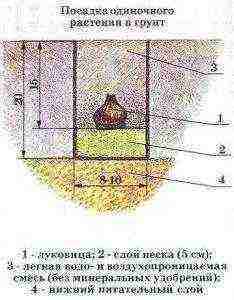 Planting hyacinths
Planting hyacinths
2 months before planting hyacinths in open ground (for the middle lane this is the end of September - beginning of November), prepare the soil, this is required in order to exclude the breakage of roots during possible subsidence of the soil. Under digging (40 cm), add humus to 1 sq. m 10-15 kg, peat, sand, 60-80 g of superphosphate, 30 g of potassium sulfate (replacing 200 g of wood ash), 15 g of magnesium sulfate (replacing 250 g of dolomite flour). If the soil is sandy, then increase the amount of potassium-magnesium fertilizers by 1.5 times. Apply nitrogen fertilizers in the spring. If humus or peat was not added during digging, then add it directly to the hole when planting.
Planting hyacinths earlier will provoke growth, because of which they will not overwinter. With a later planting of hyacinths in open ground, it is imperative to cover the site with leaves and protect it from rain, and return the shelter after planting. For planting, select medium-sized bulbs; the flower stalks will be more resistant to weather changes.
Large hyacinth bulbs (about 5 cm in diameter) are planted to a depth of 15-18 cm from the bottom to the soil surface, at a distance of 15-20 cm in a row. Smaller bulbs are planted smaller and denser. Make holes or grooves, "cover" the bottom with river sand with a layer of about 5 cm. Press the bulbs into it, cover it with sand, then soil to the end. This planting is ideal for hyacinth, since in this case the sand acts as a drainage, which will prevent the bulbs from rotting from waterlogging and protect against infection. Plant in damp soil, or water the planting if the soil was dry.
If you plan to grow hyacinths in the open field in large numbers, we recommend planting in high beds (15-20 cm) for easy hyacinth care (it is easy to set up a shelter, quickly warming up the soil in spring, protecting against waterlogging and supporting soil aeration). Make rows at a distance of 20-25 cm, plant the bulbs at a distance of at least three diameters of the bulb.
You can cover hyacinths in the garden before frost with dry peat, sawdust, spruce branches, humus. In early spring, remove the shelter, as flower sprouts appear very early.
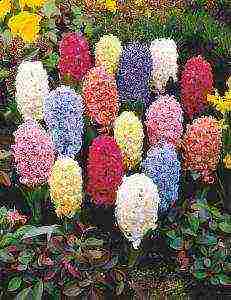 Feeding hyacinths
Feeding hyacinths
For hyacinths, feeding is one of the main ingredients in growing. In the spring, when most hyacinth sprouts appear in the open field, apply mineral fertilizers (per 1 sq. M. 20 g of ammonium nitrate, 15 g of superphosphate and 10 g of potassium chloride). When buds begin to appear, add 1 sq. m 20 g of ammonium nitrate, 40 g of superphosphate and 20-30 g of potassium chloride. Apply the third top dressing at the end of flowering (for 1 sq. M. 40 g of superphosphate and potassium chloride, without ammonium nitrate). Loosen the soil after each top dressing.
When fertilizers are applied in dry form, they are embedded in the soil, and when in liquid form, then the hyacinths are preliminarily watered and the dose of fertilizers is reduced.
Hyacinth care
Hyacinths prefer clean, weed-free soil around them.Loosen the soil regularly, starting from the emergence of shoots, the air regime of the plant is observed.
Watering hyacinths should be abundant to a depth of 15-20 cm, but not often. Watch the soil moisture especially during the budding period.
If diseased hyacinths appear, remove and burn them.
When the hyacinths have faded, cut off the peduncle with a knife, you can only remove the faded flowers (run your hand over the plant from the bottom up, what falls off will fall off, leave the rest).
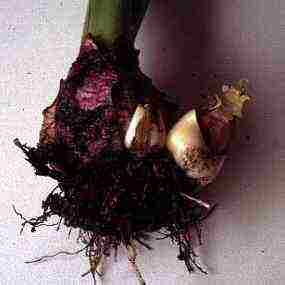 Digging hyacinths
Digging hyacinths
Digging hyacinths gives a lot of positive aspects: it improves flowering, you can examine the bulbs for damage by diseases and pests and carry out processing, select healthy children for growing.
Hyacinths are dug in late June - early July, when the leaves of the plants turn yellow and begin to deform. In this case, most of the nutrients will go to the development of the bulb. At a later digging, when the ground part of the plants disappears, it will be quite difficult to find the bulbs without damaging them, and the flowering will, as a rule, be weaker. After digging, cut off the leaves of the plants, clean the soil, and dry in a small draft in a dark room for 5-7 days (drying temperature 20 ° C). Next, clean the bulbs from the roots, detachable scales and formed children (do not separate small children).
Storage of hyacinths
Storing hyacinths is different from storing daffodil or tulip bulbs. During storage of hyacinths, a flower is formed. For storage and distillation of hyacinths, sort (by size and type) and leave only the healthiest samples, put in storage boxes in no more than 2 layers. Store the bulbs for 2 months at a temperature of 25-26 ° C, then transfer them to a room with a temperature of 17 ° C for 1 month, no more. Keep the air humidity high, as the bulbs can dry out when low. You can correct the situation by periodically sprinkling the bulbs with water.
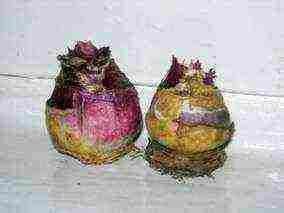 During storage, very often the bulbs form a large number of small children, so be extremely careful when planting hyacinths. Moreover, such bulbs should be planted at a depth of half the usual depth, after which the planting should be covered with mulch. Growing up a baby lasts 4-5 years. If you want to specifically call a large number of children (for reproduction by children), then after digging out the hyacinth bulbs, wipe the bottom of the bulb thoroughly with a dry cloth so as to remove all roots (do not cut off).
During storage, very often the bulbs form a large number of small children, so be extremely careful when planting hyacinths. Moreover, such bulbs should be planted at a depth of half the usual depth, after which the planting should be covered with mulch. Growing up a baby lasts 4-5 years. If you want to specifically call a large number of children (for reproduction by children), then after digging out the hyacinth bulbs, wipe the bottom of the bulb thoroughly with a dry cloth so as to remove all roots (do not cut off).
Vault rot in hyacinths it occurs as a result of such factors: storage of damaged bulbs at high air humidity and low temperatures (below 17 ° C). Determine the disease by the dry ends of the roots, the cut of the scales near the bottom is light brown. Peduncles after planting slow down growth and break. Therefore, plant those bulbs whose roots have grown ahead of time without waiting for the others, and during storage observe all the necessary modes: temperature, humidity and ventilation.
Hyacinths propagate seeds, children (natural and artificial reproduction).
Seed method of propagation of hyacinths for gardeners-breeders, it makes it possible to develop new varieties, since new young seedlings do not repeat the parental species characteristics. The flowering of seedlings begins in 5-7 years. Hyacinth seeds are sown in seedling boxes in late September. The soil for sowing is as follows: 2 parts of humus, 1 part of leafy soil and 1 part of sand. It is grown in cold greenhouses for 2 years.
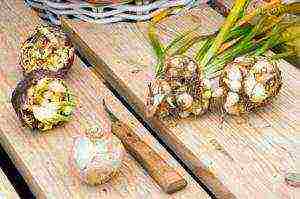 Reproduction of hyacinths by children goes slowly, since in one year the bulb can give only 1-2 babies, sometimes more. If the children are not separated from the bulb badly, then they do not need to be specially broken off for growing. Plant the bulb with the children. It happens that during storage many children are formed near the bottom (we wrote about this above), then you need to carefully plant such bulbs for growing.
Reproduction of hyacinths by children goes slowly, since in one year the bulb can give only 1-2 babies, sometimes more. If the children are not separated from the bulb badly, then they do not need to be specially broken off for growing. Plant the bulb with the children. It happens that during storage many children are formed near the bottom (we wrote about this above), then you need to carefully plant such bulbs for growing.
For mass cultivation of hyacinths use artificial propagation methods to bring out as many flowers as possible in a short time. Bulbs with a diameter of 5 cm and a weight of 80-100 g can be propagated by cutting and notching the bottom. In any case, the mother's bulb is injured here, followed by its death. Hyacinth bulbs are disinfected in a 1% solution of potassium permanganate and dried for 2 days at a temperature of 20-23 ° C.
Method for breeding hyacinths by cutting out the bottom
Using a teaspoon with a sharp edge (not a knife), cut out the bottom without injuring the middle. Check that the bases of all scaly leaves have been removed. Treat the sections with a fungicide to prevent the appearance of diseases. Place the bulbs in boxes or on a wire mesh or dry sand surface with the cut side up. Now for 2-3 months in this position, the bulbs are stored at a temperature of 21 ° C for the formation of young bulbs on the slices (one bulb will give 20-40 children with a diameter of 0.5-1.0 cm).
Plant the bulbs with the babies in the same position in the pot so that the babies are just a little covered with the soil mixture. Temper the plants, then move them to a cold greenhouse. In the spring, the babies will give leaves and grow, taking strength from the mother's bulb. When the growing season comes to an end, the bulbs are dug up and planted. Flowering begins in 3-4 years.
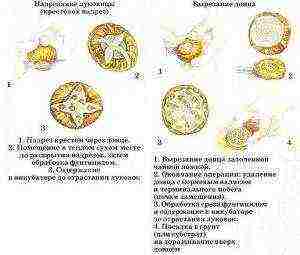
Method for breeding hyacinths by notching the bottom
This is an easier way of reproduction, with fewer babies (8-15 pcs), but with a larger diameter, which will start flowering in 2-3 years.
Disinfect the bulbs with 1% potassium permanganate solution. Use a sharp knife to cut the bottom of the mother bulb to a depth of 0.5-0.6 cm: on large bulbs, 4 cuts at right angles to each other (2 crosswise), on small bulbs, 2 cuts are enough. After the "operation" place the bulbs for a day in a dry room with a temperature of 21 ° C to open the slices. Treat the sections with a fungicide and proceed according to the previous scheme.
The same breeding methods can be used for daffodils and muscari.
You can grow hyacinths in pots in a prikop, prolonging flowering period
The aroma of hyacinths can be heard already in mid-April, at this time the flowers begin to bloom their inflorescences. If hyacinths are planted in a sunny area, then in warm spring they will fade very quickly. If you plant hyacinths in a slightly shaded place, then flowering will last a little longer. You can grow hyacinths in pots and adjust the flowering time yourself.


Usually, containers are used for planting flowers: pots, tubs, bowls, boxes, etc. All these containers with flowering plants can be placed on the windowsill, and in the spring they can be placed in the foreground of the garden, flower beds, pots, decorating "artificially" your summer cottage landscape. This flower arrangement of hyacinths will perfectly decorate any container, even a basket.
The period for planting in pots in the buried hyacinths is the same as for planting in open ground, i.e. about the month of October. Dig a trench in an open area so that in winter the sun's rays reach it as much as possible. Length and  the width of the trench depends on the size and number of containers, but the depth should be such that there is another 15 cm from the top edge of the containers to the surface of the ground.After planting the hyacinth bulbs in a pot, wrap it with something to protect the pot from dirt and hypothermia (even newspapers). Place the hyacinth pots in the trench, lay a layer of fallen
the width of the trench depends on the size and number of containers, but the depth should be such that there is another 15 cm from the top edge of the containers to the surface of the ground.After planting the hyacinth bulbs in a pot, wrap it with something to protect the pot from dirt and hypothermia (even newspapers). Place the hyacinth pots in the trench, lay a layer of fallen 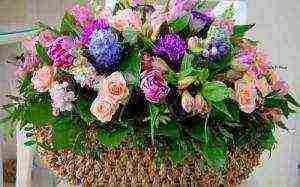 foliage, dig in with earth and lay a layer of foliage again. This will protect the bulbs from the cold.
foliage, dig in with earth and lay a layer of foliage again. This will protect the bulbs from the cold.
To speed up the onset of flowering hyacinths in pots at the beginning of March, remove the containers from the trench (Not all! To extend the flowering time.) and transfer to a warm place, the plants respond well to heat (the arrows will immediately grow). Potted hyacinths will start blooming at the end of March!
Blooming and fragrant hyacinths in pots can be left at home, taken out to a glazed balcony, and in good weather for a day in the garden (at night, bring back to warm or leave in the garden, but cover with spunbond).
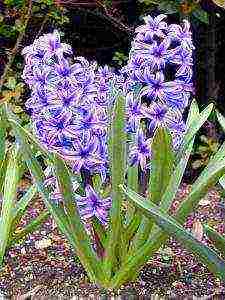 To delay the flowering of hyacinths in pots in mid-March, remove the containers from the trench (not all!) and transfer them not to heat, but to a cool place, basement or cellar. Inspect the plants regularly and water them. In mid-April, move the hyacinth pots to a warmer place and gradually expose them to a brighter light. Thus, the blooming of hyacinths will begin only in late April - early May!
To delay the flowering of hyacinths in pots in mid-March, remove the containers from the trench (not all!) and transfer them not to heat, but to a cool place, basement or cellar. Inspect the plants regularly and water them. In mid-April, move the hyacinth pots to a warmer place and gradually expose them to a brighter light. Thus, the blooming of hyacinths will begin only in late April - early May!
When the hyacinths in the pots start to bloom, pull the next batch of containers out of the trench so that you and those around you can admire the beautiful flowers for longer.
Taking care of potted hyacinths is much more difficult. It requires regular feeding and moderate watering. Dig up the bulbs when the foliage of the plants is completely yellow (around the end of June). Clean the bulbs from the ground and store in a dry place until planting in the fall. If the bulbs are not dug out, the next flowering will be weaker.
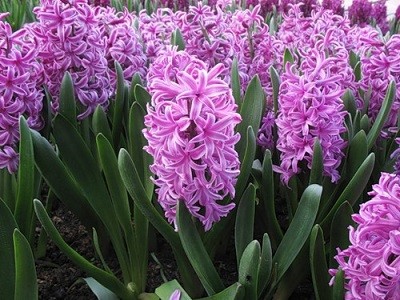
Hyacinth is one of the earliest spring flowers. His bright, multi-colored cobs make their way out of the ground as soon as the snow melts and decorate the still empty flower bed.
In order for hyacinth to bloom beautifully at the right time, it is necessary follow the rules planting and caring for him.
…
Pick-up location
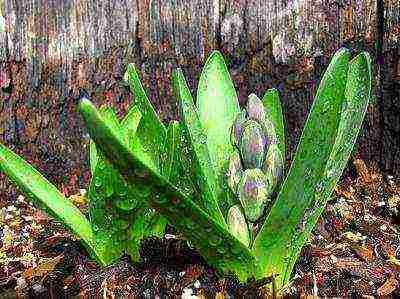 To place hyacinth plantings in open ground, it is necessary to select a site where there will be no stagnation of water. A site with a slope or on a hillock is best suited.
To place hyacinth plantings in open ground, it is necessary to select a site where there will be no stagnation of water. A site with a slope or on a hillock is best suited.
It is also necessary to take into account that the location of groundwater under this site should not be closer than 70 cm to the surface.
For hyacinth in the garden is also important soil composition... The soil must be light, breathable and permeable to water.
The flower is picky about the amount of nutrients in the substrate. Acidic soil must be calcified, and a sufficient amount of sand or peat must be added to clayey soil.
Outdoor cultivation
Landing times and rules
Hyacinths are planted from late September to early November... Early planting will provoke growth, and the flower will not be able to overwinter. If you are late with planting, then cover them with a layer of foliage.
Before this, the soil must be carefully prepared. You need to dig up the site in 2 months. At the same time, humus is introduced 10-15 kg, superphosphate - 70-80 g., Potassium sulfate or wood ash - 200 g., Dolomite flour or magnesium sulfate - 250 g. per square meter.
In the holes also add humus... But you cannot add fresh or slightly rotten manure.
How to choose and prepare the bulbs?
The bulb is spherical. Its core consists of an embryonic bud, which is surrounded by numerous scales that form over four years. The planting material becomes full-fledged by the age of 5-6. After the sixth year, daughter scales appear on the bulb, from which new specimens can be grown.
Planting material, depending on the variety, has different sizes. Terry varieties have the smallest onion.
Bulbs are suitable for planting in open ground not less than 4 cm in diameter... Moreover, they must be dense, elastic, without damage. The root buds should be visible on the underside.
IMPORTANT!
The bottom of a high-quality bulb should be one and a half times less than the base in diameter.
Landing rules
Before placing the hyacinth in the soil, it should be disinfected - soak for 30 minutes in a solution of potassium permanganate or foundation.
The bulbs are spaced at least 20 cm apart. A distance of 10 cm must be left between the small ones. The holes are dug in such a way that the bulb is deepened by no more than 15 cm. The bottom of the hole must be laid out with a layer of sand, which acts as a drainage.
After planting, the hyacinths are sprinkled with a layer of soil, and then covered with a mulch layer. With the onset of frost, the site with plantings is additionally covered with spruce branches or branches.
To implement correct planting and care of hyacinths in the garden in the open field, photos will help you: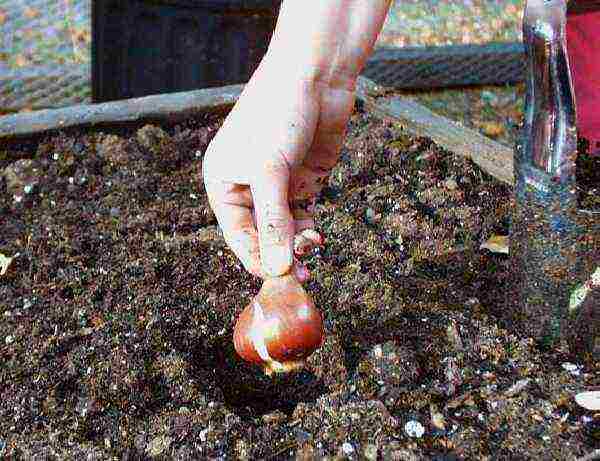


Spring care
As soon as the snow cover comes off the site, the mulch layer is removed. Immediately after the snow melts, they do not need to be watered, since there is enough moisture in the soil, and waterlogging is dangerous for hyacinths, they can become infected with a fungus.
Watering is necessary only if there is no rain and significant drying of the soil is visible.
Three times during the growing period of hyacinths should be fed: after the first shoots appear, during flowering and immediately after flowering. The first feeding is carried out with saltpeter. In the second, superphosphate and potassium chloride are added to a small amount of nitrate. The third top dressing consists of superphosphate and potassium chloride.
IMPORTANT!
Do not apply nitrogen fertilizers after flowering, so as not to provoke re-growth of the bud.
Preparing for the new season
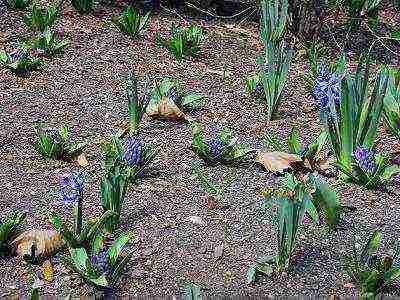 After flowering wait until the leaves are completely dry, only after that they need to be dug up.
After flowering wait until the leaves are completely dry, only after that they need to be dug up.
An annual procedure for removing bulbs from the ground is a must. If they are not dug up, the flowers become smaller.
The bulbs are dug up in June-July. They are thoroughly cleaned of leaves and earth. It is advisable to rinse the bulbs in a weak solution of potassium permanganate and dry.
IMPORTANT!
Do not prune the leaves, but carefully separate them from the bulb by hand.
Drying process lasts one to two weeks. Bulbs should be stored at 18-20 degrees in a dry place. Then the hyacinths are packed in paper bags or cardboard boxes. Further storage of planting material is a crucial moment, since it is at this time that flower buds are laid.
For two months, the bulbs are kept in a room with a temperature of at least 25 degrees. Then the temperature should be sharply reduced to 15-17 degrees. The air humidity needs to be increased so that the bulbs do not dry out.
ADVICE!
If there is not enough moisture in the air, the bulbs can be lightly sprayed with water.
How to propagate a plant?
Reproduction of hyacinths is carried out by seeds and children.
- Seed method. With this method, you can get varieties of new colors. Hyacinths grown from seeds will bloom in 6-7 years. Sowing is carried out in boxes filled with a mixture of humus (2 hours), leaf earth (1 hour), sand (1 hour). The growth of bulbs from seeds lasts 2 years.
- Reproduction by children. The mother bulb gives 1-2 babies a year after it reaches 4-5 years of age. It is possible to separate the baby from the main bulb only when it practically falls off from it. If the baby is holding on tightly, you cannot break it off.
The resulting babies are planted in a separate area at a shallow depth. The plantings are covered with a large layer of mulch.
Accelerated breeding method
It is an artificial increase in the amount of planting material. For this method, you will need to donate an adult bulb, which will no longer be able to give flowers.
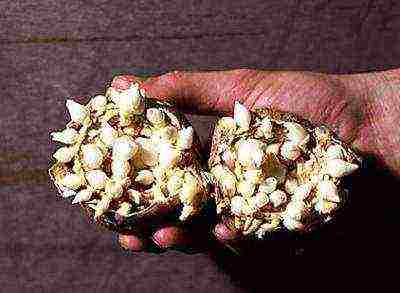 Hyacinth can be propagated quickly in two ways:
Hyacinth can be propagated quickly in two ways:
- Interruption of flowering.As soon as a peduncle appears from the center of the bulb in the spring, it must be cut out, and continue to care for the hyacinth as usual. This technique allows you to direct all the forces of the mother's bulb to the formation of children, and after the leaves are dying off, you will dig the bulb out of the ground and find it dividing into a large number of small bulbs.
- Cutting the bottom.At the bottom of an adult bulb, a cross-shaped incision is made 0.5 cm deep. After that, the bulb should be held in a dry, warm room for 24 hours, where it will open. Then it is treated with a fungicide and planted in the ground with a cut up. 8-10 small bulbs grow at the cut site.
Growing hyacinth requires some effort.But if you follow all the rules, it will delight you with bright and fragrant inflorescences for more than one spring.
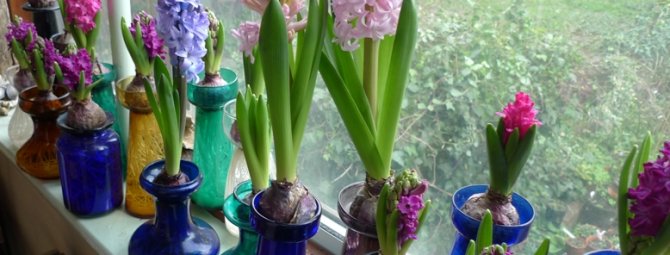
Hyacinth is a flower of the asparagus family with a pronounced pleasant aroma. It is a versatile plant that is grown indoors and outdoors. But in a pot, it will not bloom many times: this is possible only when transplanted into open ground.
Why hyacinths are grown in pots
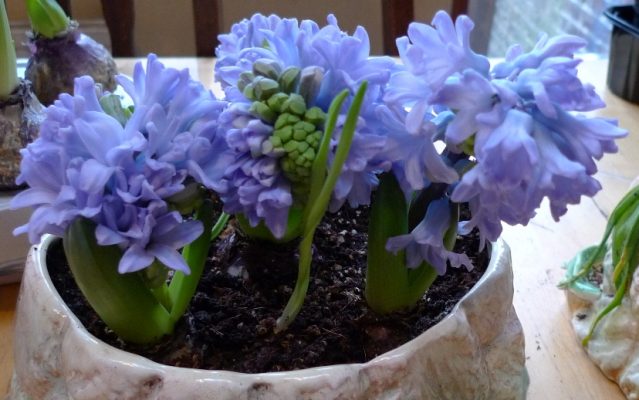
Flowers are grown both in pots and outdoors
Hyacinth is a perennial bulbous flower that quickly responds to the creation of favorable conditions with lush flowering. After that, the bulb needs rest, which is otherwise called the "state of rest". During this period, plant organs begin to form in it, which will delight with its beauty for the next season. These are natural processes for all bulbous plants, and hyacinth is no exception.
But at home, you can change the natural rhythms of the plant and get beautiful flowers by the desired date. This process is compulsory and is called “forcing”. Two options are possible: in water and in soil.
There are three types of forcing, depending on the growing period:
- early (by the end of December);
- medium early (getting flowers in the middle of winter);
- late (flowering in early spring).
Important! The bulb can gain strength for further flowering only in natural conditions. To do this, it is transplanted into the ground. Before the onset of frost, they are dug up and transferred to the house. Then it can be used again for germination by a certain date.
When selling blooming hyacinths, a label with the text is often attached to the pot: discard the bulb after flowering. In this way, sellers inform that they cannot receive a flower again in the pot. To do this, you must act in accordance with the note suggested above: transplant the bulb into the soil on the street.
Residents of cities are often deprived of such an opportunity and do not know how to properly grow hyacinths. The bulb can not be thrown away, but planted in the local area, dacha or in any flower bed you like. It is likely that by the end of autumn she will give 1–2 babies.
Correct distillation of flowers
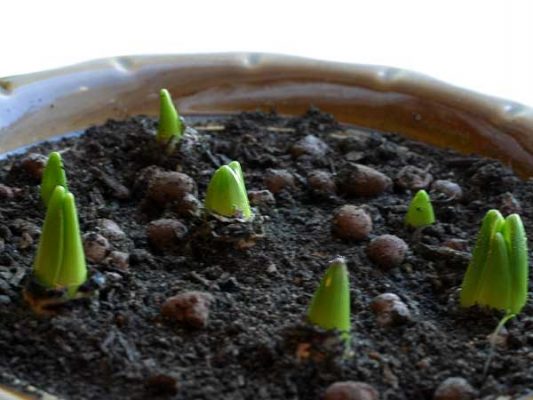
The choice of quality planting material is very important for successful flowering.
The success of forcing hyacinths largely depends on the type of plant and how well the bulb is chosen. A number of requirements are imposed on the planting material.
Preparing the onion
In order for the hyacinth to bloom in a pot, it is necessary to properly prepare the bulb. This only applies to seed that has been dug out of the ground. If an onion is bought in a retail network, it is obviously believed that it has passed all the stages of preparation listed below.
- Bulbs intended for germination are dug up in the middle of summer. They are cleaned of soil and kept for 14-15 days in conditions of high humidity at + 30 ° С.
- Then the temperature is reduced to + 25 ° C and the seed is kept for two weeks.
- Further, until planting, the bulbs are kept at + 17 ° C.
Boarding time
The rooting period of the bulb is 6-10 weeks, depending on the variety and quality of the seed. If they want to grow flowers by a certain time, they are guided by the time-tested ones:
- flowers by the beginning of the new year and Christmas - planting in the first half of September;
- by March 8 - at the end of October.
Soil preparation
Any small containers are suitable for planting hyacinths: plastic cups, deep disposable plates, pots, jars.

For planting, you will need a certain list of materials and tools.
- A drainage with a thickness of 10–20 mm is formed at the bottom. These can be small stones mixed with sand.
- Next, a layer of soil is poured. You cannot use sour hyacinths for growing hyacinths. The optimal choice is a mixture in equal proportions of leafy soil, turf and compost, add a little sand and peat. You can also mix lowland peat and coarse sand in equal proportions.Another option is to buy ready-made potting soil at a gardening store.
- A 5–7 mm layer of sand is poured onto the substrate. This is a precautionary measure to prevent root decay of the plant.
Landing
For forcing, deep pots 14–20 cm high are used. In the process of growth, the bulb will inevitably grow and protrude above the soil surface. Therefore, you need to plant it in the upper third of the pot, and not at the level of its edges.
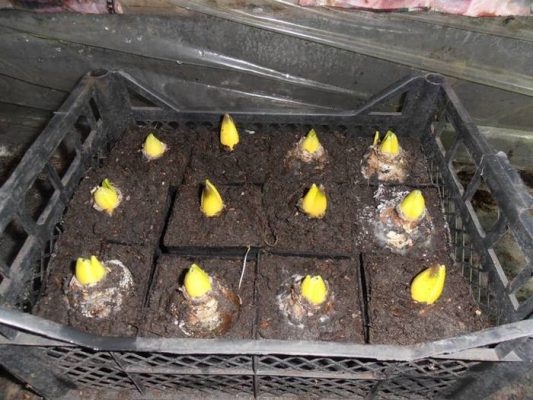
For commercial purposes, hyacinths are grown in small boxes, but each bulb is in a separate cell
The planting process consists of several stages:
- the bottom of the bulb is slightly pressed into the ground (do not screw it in!);
- sprinkle with earth so that the upper part of the bulb is free, protrudes above the ground level;
- dusting of the upper part with dry sawdust is permissible.
Attention! If several bulbs are planted at once, they should not be in contact with each other. In this case, the landing should be sufficiently crowded. The optimal distance between them is 2–2.5 cm.
Rooting period
After the flower is planted in a pot, it needs a rest period. At this time, the following conditions are provided:
- complete lack of lighting;
- air temperature + 5–7 ° С;
- normal humidity.
During the rooting period, constantly make sure that the soil in the container is moderately moist. Drying out is unacceptable. For the purpose of disinfection and feeding, the soil is watered with a solution of potassium permanganate and sprinkled with wood ash. The duration of the rest period is 2–2.5 months.
Storage space for pots:
- lower shelf of the refrigerator;
- cold loggia;
- basement or cellar;
- garage.
The rest period is also called "cold". This is an indispensable step in the forcing of bulbous flowers.
The final stage of forcing
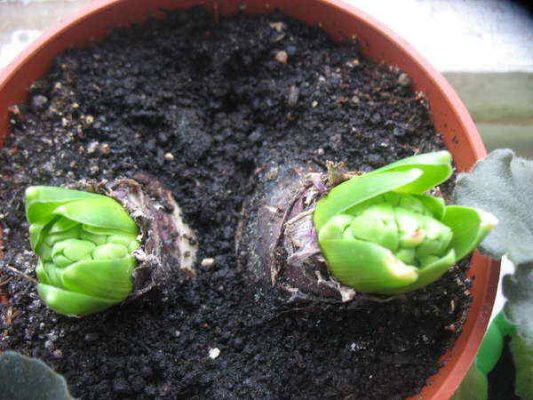
—
Two months after planting, they begin to regularly check for sprouts. Once they reach a height of 2–2.5 cm, the seed pots are transferred to a cool and well-sunlit place. Optimally - on the windowsill. The flower should be here for the entire next month. In the first week after the end of the cold period, it is advisable to cover the pots with a paper cap.
Attention! During this period of plant growth, the air temperature should not exceed + 15 ° C.
At the end of this stage, buds appear and the pot is transferred to the place where it will constantly be. Further, the beginning of flowering is expected. Hyacinths do not tolerate excess moisture well, so you need to water it regularly, but in moderation.
Distillation in water
To obtain a "water" flower, before planting, they go through all the same stages as when growing in a pot. It is important to choose the right water container. It should be such that the bulb does not sink in liquid, but comes into contact with it with its lower, root part. In order to achieve this, you can use a variety of devices. Narrow glasses are a good choice.
The water must be clean: rain or filtered. The container must be wrapped in dark paper and the plants are sent to a cool place for the cold period. All this time, they monitor the level of the liquid and top it up in a timely manner. After the first roots appear, fertilizer is added. For example, "Kornevin".
How to choose a good, healthy plant in the store
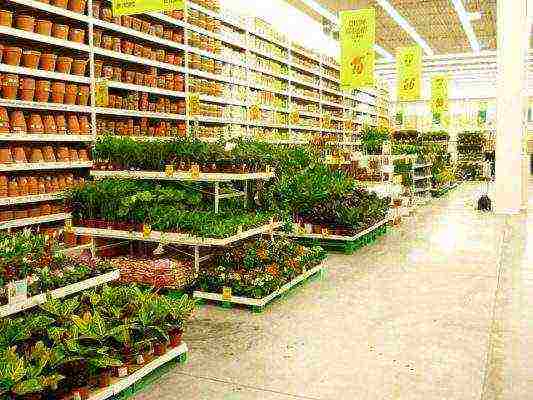
Flowers bought in a hypermarket require special care, which sometimes cannot be provided at home.
The success of growing hyacinth in a pot directly depends on the quality of the seed. In order to avoid mistakes, the following rules are recommended.
- For forcing, use bulbs with a diameter of at least 50 mm. If hyacinths are to be grown in the garden, a smaller seed will do.
- Depending on the variety, the maximum permissible bulb diameter for growing hyacinth in a pot is 40–60 mm.
Requirements for the appearance and quality of the seed:
- lack of rot and mechanical damage;
- smooth surface;
- absence of traces of damage by pests and diseases;
- firm to the touch structure.
Important! The main criterion for choosing a hyacinth for growing in a pot is the ratio of the diameter of the bulb to its bottom. It should be 1.5-1.6: 1. This ratio is much lower for unsuitable seed.
The purchased flower was brought home, how should you care for it?
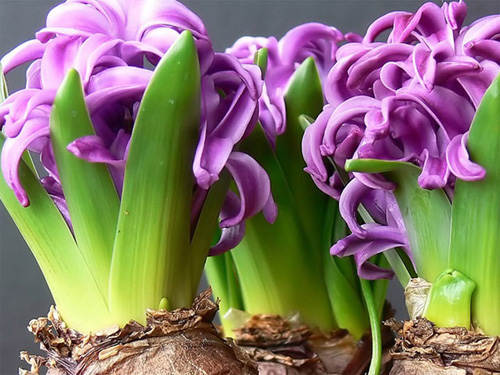
Usually, blooming hyacinths are not transplanted, but this rule does not apply to plants purchased in garden stores.
The hyacinth bulb can be purchased at any time of the year. If there is no intention to immediately send it for distillation, then place it in a cool place for storage at a temperature of 6–9 ° C. This will halt the growth processes and initiate a period of dormancy. If a potted bulb is purchased, it is placed in a well-lit area for forcing.
Is it worth replanting from a store pot
As for whether it is necessary to transplant hyacinth from a store pot, the opinions of flower growers differ. Some believe that it is undesirable to injure the flower with a transplant. Others do not see any danger to the plant in this process. In order to decide what to do next, the situation is assessed according to several parameters:
- flower condition: rooted bulb, there are sprouts, blooms;
- pot size;
- what will be done with the plant after it has faded.
Most often, hyacinths are sold in their best marketable form: flowering. At the same time, the bulbs are planted in such small containers that the soil is almost invisible. Vegetation of plants in such conditions is supported by watering with chemicals. As soon as this process stops, the flower may die. Therefore, in order to preserve the life of a flower, after purchase, hyacinth must be transplanted into a pot with soil, regardless of whether it blooms or not. If it is purchased in a container with a sufficient amount of substrate, it is better to refrain from transplanting. After the hyacinth has faded, the bulb is dug up and sent to a dormant period.
Conditions for growing hyacinth in a pot

Try not to put hyacinths on windowsills, where there is a high probability of drying out from radiators.
The hyacinth pot is placed in any bright, warm place. Closeness to heating devices is undesirable: radiators and various heaters. For normal vegetation, the plant needs room temperature.
During the ripening period of the buds, hyacinth can be illuminated in the evenings with an incandescent or fluorescent lamp. The optimum temperature for flowering is 20 ° C. Watering should be moderate but constant. Do not allow the soil to dry out. It is important to exclude the ingress of water on the top of the bulb and in the leaf axils.
Therefore, water is poured at the edge of the pot. This will inevitably cause gradual erosion of the substrate. In order to avoid this, the container with the flower is periodically turned. It is also useful for the stem of the plant to grow upright. If necessary (if the soil is not nutritious enough), fertilizing with mineral fertilizers is possible.
The conditions listed above are considered ideal for growing hyacinths in a pot. But it is not always possible to provide them. However, do not worry about this: hyacinth is quite unpretentious and will definitely bloom at room temperature and normal room lighting.
What care to provide hyacinth after flowering
Inexperienced growers are at a loss as to what to do with hyacinth after it has faded. It all depends on whether you intend to get another full-fledged plant from this bulb. If not, the flower is dug up and thrown away. But you can do another way: dig up the onion and transplant it into the garden. Here she will rest and give new flowers, subject to proper care.
If there is an intention to engage in reproduction and further cultivation of hyacinths, proceed as follows.
- When the plant has faded, the flower is cut.
- Moderate watering and feeding are continued until the leaves remaining on the trunk wither.During this period, the bulb will gradually increase in size and children may appear.
- Next, the bulb is removed from the soil and cleaned of dried leaves. If there are children, separate them.
- Those bulbs that have faded after distillation are not suitable for re-use. But they can be planted in the ground in a flower bed or in a garden.
The maximum "lifespan" of hyacinth bulbs is 10 years. All this time they give flowers once every 1-2 years.
Landing in open ground
The coachman plant hyacinth bulbs only when they want to get a lush bloom
On average, hyacinths bloom for 1.5–2 weeks. At the final stage, drying of the peduncle and leaves is observed. From this point on, watering is gradually reduced and completely stopped after the flower dries.
Attention! You cannot cut off the green mass and flowers before they dry, since during this period there is an outflow of nutrients into the bulb.
The peeled onion is planted in the ground at a temperature of + 20-30 ° C. The optimal period is the first half of autumn. Planting is carried out to a depth of 10–12 cm on dense heavy soils and 12–15 cm on loose and light soils.
- Form a hole of the appropriate depth.
- Pour a layer of sand 1–2 cm on the bottom.
- The distance between the bulbs is 8-9 cm.
- Before freezing, cover the planting site with a 10 cm layer of mulch.
Diseases and pests
Like any other plant, this flower can be affected by various diseases and pests. The following are most common when growing hyacinths in pots.
Yellow bacterial rot

With the disease, the leaves of the plant are affected, and then the bulbs (in the photo is an orchid)
The disease is accompanied by liquefaction of the bulb, a pronounced unpleasant odor, and cessation of plant growth. At the initial stage of the lesion with yellow rot, gray spots appear on the leaves.
Parasitic apical rot
The disease is caused by pathogenic microorganisms in the contaminated soil. Signs of illness:
- brown shallow depressions on flowers and leaves;
- the tips of the leaves are covered with mycelium, become thinner and destroyed;
- roots rot.
Decay processes are accelerated when the air temperature rises.
Mosaic

First the leaves dry out, and then the whole plant
Chaotically spaced elongated light green spots appear on leaves and flowers. The affected areas begin to turn yellow and dry. Plant growth slows down. Death is possible.
Gray rot
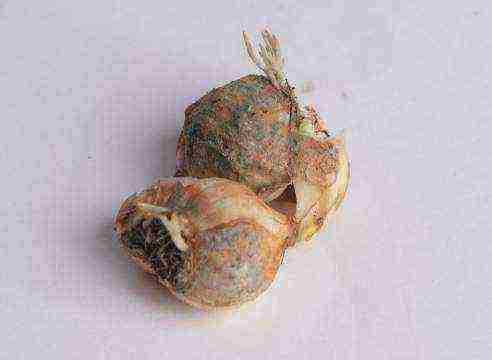
Gray rot leads to the death of the bulbs (pictured is a tulip bulb)
Most often it affects plants during the period of the beginning of growth. The disease is characterized by the formation of yellow spots, which gradually increase in size and acquire a brown color. Rotting of the roots begins quite quickly. The plant dies.
Pests
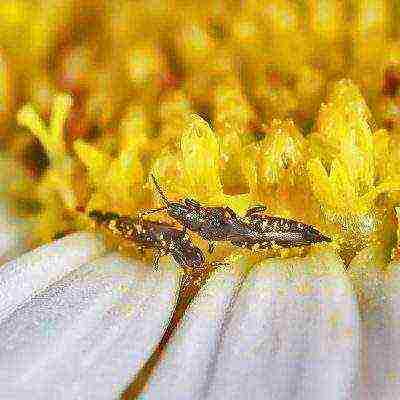
One of the parasites of hyacinths is tobacco thrips
When grown outdoors, the most dangerous pests for hyacinths are aphids and thrips. They take the sap from the plant, which leads to the drying of flowers and leaves. For the prevention of damage, spraying with aphicides is carried out. The most effective are Fitoverm, Akarin, Akkord.
Potted and outdoor plants can suffer from nematode infestation. These parasites are of two types: stem and gall. Most often, the first are found, parasitizing on all parts of the plant, ground and underground. At the same time, the bulbs soften, the growth of the hyacinth gradually stops.
There are no radical measures to combat these parasites. On sale there is the only drug to which nematodes are sensitive - "Fitoverm". It is used as a therapeutic and prophylactic agent. Before planting on the soil, pour the powder of this preparation in a thin layer and mix it with the ground to a depth of at least 15 cm.
Possible problems when growing hyacinths: table
A novice florist will be helped by a table of possible mistakes when growing hyacinths in a pot and how to fix them.
Reproduction of hyacinths at home
In nature, hyacinth reproduces by children.Moreover, the bulbs grow them for a very long time: 3-5 years. For obvious reasons, this method is of little use for domestic breeding. Over the years of breeding bulbous flowers, several optimal methods for their reproduction have been found:
- seeds;
- children;
- cuttings;
- cutting out the bottom;
- by dissecting the bulb (propagation by scales).
The most laborious and time consuming is the first method of reproduction: by seeds. It is most often used if you want to get flowers of a rare variety, the bulbs of which are not for sale.
Reproduction by children
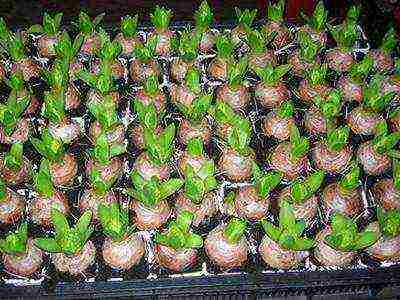
Reproduction by children is the simplest
Highly productive, most commonly used method. Beneficial for several reasons:
- the first flowering is obtained in the third year after planting;
- all traits of the parent plant are inherited;
- high survival rate.
Stimulation of the formation of children is carried out by crosswise incising the bottom of the mother's bulb.
Cuttings
Cuttings are harvested during the period of bud formation.
- Choose a leaf with a handle and cut it as close to the trunk of the plant as possible.
- The cut is treated with a disinfecting and growth-stimulating drug.
- Planted in a container with a substrate or under a film.
After 3-4 weeks, rooting occurs. After 50-60 days, the first shoots of a new plant appear. In the first two years, the bulb is not dug up, it is left to winter under a thick layer of mulch.
Cutting the bottom
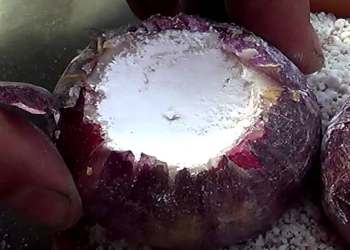
This method is best used by experienced florists.
This propagation method uses large bulbs. The sequence of actions is as follows:
- wash the seed from soil residues;
- laid to dry for 5-7 days;
- with a sharpened knife, cut out the bottom of the bulbs so that a cone-shaped hole is obtained;
- the place of the cut on the bulb and the cut out bottom is treated with a fungicide solution (you can use crushed charcoal);
- the cut-out bottoms are laid with a cut up and covered with plastic wrap.
The first babies with a diameter of 5-10 mm appear after 2-3 months. If the air temperature allows (not lower than + 30 ° C), you can land in the ground.
Dissecting the onion
This propagation method requires dense, large bulbs. Using a sharp knife, they are divided into 5-6 parts. Each slice is disassembled into scales. All sections are treated with a disinfectant. The obtained seed is stored in plastic bags. In the first month at a temperature of + 20–25 ° С, in the second - + 17–20 ° С.
If you wish, you can grow beautiful hyacinths in a pot at home. This will help detailed instructions for each stage of preparation and germination of seed, caring for a flowering plant.
Rate the article:
(0 votes, average: 0 out of 5)
